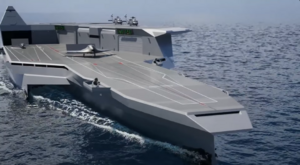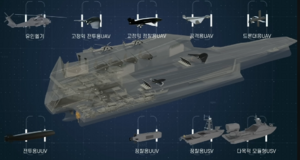Yong-Wang class unmanned aerial vehicle carrier

| |
| Class overview | |
|---|---|
| Name: | Yong-Wang class unmanned aerial vehicle carrier |
| Builders: | Hanwha Ocean Co., Ltd. |
| Operators: |
|
| Cost: | 4.0 billion NSD $ |
| Built: | 2021- |
| In service: | 2023-present |
| Planned: | 19 |
| Building: | 8 |
| Completed: | 10 |
| Active: | 9 |
| General characteristics | |
| Class and type: | Drone carrier |
| Displacement: | 29,000 tons, full load |
| Length: | 215 m |
| Beam: | 41 m |
| Draft: | 8.5 m |
| Propulsion: | CODLOG, Pump-jet |
| Speed: | 35 knots(Maximum speed) |
| Range: | 12,964 km |
| Complement: | 50(Crews)+124(Airwing) |
| Sensors and processing systems: |
|
| Electronic warfare & decoys: | LIG Nex1 SLQ-200(V)K SONATA ESM/ECM |
| Armament: |
|
| Armour: | Classified |
| Aircraft carried: | 24 UAVs or UCAVs + 6-12 Helicopters |
The Yong-Wang class unmanned aerial vehicle carrier is a ship designed and built to use aerial and maritime drones to perform sea blockings, air missions, anti-submarine missions, fleet battles, and more. The Yong-Wang class is one of the results of a project implemented by the Royal Joseon Armed Forces to prepare for future wars using drones as military drones gradually expand their role on the battlefield.
The Yong-Wang class is a type of drone carrier that acts as an operation and resupply platform for aerial and maritime drones and acts as a mothership to closely connect drones and control them. The operation and control of drones require human crew intervention, but artificial intelligence assists humans in combat assistance, battlefield environment analysis, and the operation of internal facilities of ships. In particular, since there are many areas where artificial intelligence(AI) is in charge of operating facilities inside ships, the Yong-Wang class can operate smoothly with only 50 crew members.
Description
Design
Yong-Wang class has unmanned much of the ship's maintenance. The ship's AI and management systems are responsible for many areas, ranging from rearmament, turbine system/combustion Technician, fuel and supplies, steering, computerized work, and cleaning. The Yong-Wang class's internal structure was designed to optimize these unmanned operations, and as a result, human crews are only responsible for some areas, such as command, aviation, and special operations.
Yong-Wang class has a Trimaran structure. This allows the Yong-Wang class to sail faster and more reliably through the waves. In addition, the trimaran structure has a significant effect on suppressing motion sickness in sailors. Also, Yong-Wang class adopts a stealth form, so it is detected as a smaller vessel on the radar. The Navy's experiments have shown that the Yong-Wang class is detected as the size of a small ship with a displacement of 500 tons on a typical S-Band AESA radar.
Defense capability
Yong-Wang class is equipped with 16 cells of Mk. 41 VLS. The Mk. 41 VLS is a system that is responsible for the core of ship defense, and can carry up to 64 K-SAAM or ESSM missiles capable of carrying 4 in a single cell.
Air/Sea operational capability
Yong-Wang class is equipped with two EMALS catapults, which assist the aircraft to take off. All fixed-wing UAVs and UCAVs can take off with acceleration through the EMALS catapults. Also, the landing of the aircraft is assisted by 3 arresting gears.
Fixed-wing UAVs/UCAVs are at the core of the Yong-Wang class's air operational capabilities. UAVs/UCAVs are the primary combat assets responsible for aerial reconnaissance and attacks, and they are also the most important unmanned assets of the Yong-Wang class. Unmanned surface vehicles are responsible for maritime reconnaissance, sea blockade, and enemy fleet attacks. The Yong-Wang class is equipped with 3 reconnaissance USVs and 4 combat USVs, and when the reconnaissance USVs detect the target, the combat USVs will launch an attack. Unmanned underwater vehicles are responsible for underwater reconnaissance, underwater attacks, and anti-submarine missions.
Aerial wings
- 1 Air combat UCAV squadron (12 Aircraft. KMAQ-2 Unmanned Combat Aerial Vehicle) + 1 Strike mission UCAV squadron (12 Aircraft. RAQ-39B Clarion)
- 1 Anti-Submarine warfare helicopter squadron (8 Helicopters. NUH-1)
Or
- 2 Air combat UCAV squadrons (24 Aircraft. AQ-46A Storm Petrel or KMAQ-2 Unmanned Combat Aerial Vehicle)
- 1 Anti-Submarine warfare helicopter squadron (8 Helicopters. NUH-1)
Unmanned surface vehicles
Unmanned underwater vehicles
